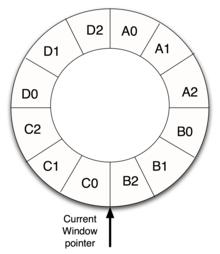Tab window
Register windows are a form of organization of the process-oriented register . These enable rapid switching back and forth between different processes (also known as multithreading) without the need for time-consuming reloading of the register contents, since the register can be switched to the "window" required by the active process.
construction
The existing registers are divided into three sections (windows): In, Out and Local. A Current Window Pointer (CWP) points to the currently active window. If the process now changes (by starting a new process or terminating an old one), the CWP is incremented (increased) or decremented (decreased) in order to point to the next window. The previously used register windows are still available to the new process after renaming the registers, but under new names.
advantages
With a relatively small number of registers, it is possible for many processes to work in parallel without laboriously storing or removing the contents of the registers.
disadvantage
In the case of heavily nested procedure calls, the advantage of the register window cannot be used, as a certain number of active processes saturation occurs, depending on the number of register windows.
implementation
The SUN UltraSPARC II used 32 64-bit registers according to the above principle.
swell
- Andrew S. Tanenbaum, James Goodman: Computer Architecture, 4th Edition, 2001
